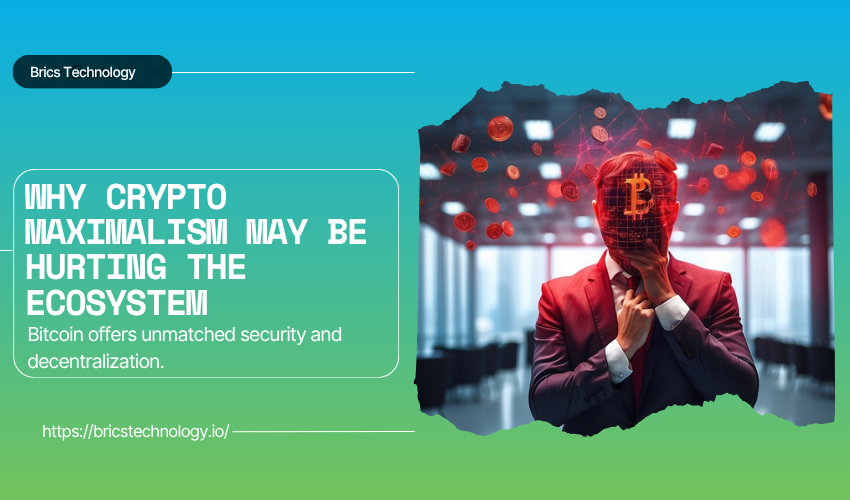Why Crypto Maximalism May Be Hurting the Ecosystem

Crypto began as a revolution — a decentralized pushback against traditional finance, powered by innovation, inclusion, and open technology. But as the industry matures, a growing tribalism threatens to undermine the very principles it was built on. This ideology, often referred to as crypto maximalism, is creating deep rifts in a space meant to be diverse, experimental, and collaborative.
Whether it’s Bitcoin maximalists dismissing all altcoins as scams, or Ethereum purists downplaying competitors without engaging in dialogue, the ecosystem is seeing less open-minded exploration and more echo chambers. According to discussions highlighted by etherions .com, this behavior is no longer just a quirk of internet culture — it may be actively slowing innovation and discouraging newcomers.
So, what exactly is crypto maximalism, and why is it becoming a problem?
What Is Crypto Maximalism?
Crypto maximalism is the belief that one cryptocurrency — often Bitcoin, but sometimes Ethereum or another chain — is the only viable long-term solution, and that all others are either inferior, unnecessary, or outright harmful.
This philosophy originally gained traction among early Bitcoin adopters, who viewed BTC as not just the first, but the only true path to decentralized, sound money. That belief system has since spilled over into other communities, each convinced their protocol is the one that will “win” — and that everything else is noise.
At its best, maximalism is passionate advocacy. At its worst, it becomes exclusionary, toxic, and blind to nuance.
Tribalism Over Technology
The crypto space thrives on innovation. Layer 1s and 2s, privacy coins, zero-knowledge rollups, DeFi, DAOs — the list of experiments pushing the boundaries of digital finance is long and constantly evolving.
Yet maximalist thinking often dismisses or even attacks these innovations if they fall outside the “one true chain.” Instead of healthy debate, there’s dogma. Instead of collaboration, there’s factionalism.
This has led to:
- Divisive social media wars that deter newcomers.
- Missed opportunities for cross-chain development.
- Misinformation about competing protocols.
When builders are shamed for working on “non-canonical” chains, the entire industry suffers. Valuable projects may never gain traction, not because they lack merit, but because they lack tribal approval.
Echo Chambers and Algorithmic Bias
Much of this problem is amplified by the algorithms that govern social media. Platforms like Twitter and Reddit often reward the loudest, most polarizing voices — not the most nuanced. As a result, maximalist content is often what gains the most visibility, reinforcing closed thinking among followers and newcomers alike.
These echo chambers create the illusion of consensus, where dissent is not just unwelcome — it’s vilified. Even well-reasoned criticism can be dismissed as “FUD” (fear, uncertainty, doubt) if it challenges the dominant narrative.
This stifles healthy discussion and prevents the community from honestly addressing weaknesses, bugs, or security risks within their favored protocol.
The Problem with “One Chain to Rule Them All”
In tech — especially decentralized tech — monocultures are dangerous. Diversity isn’t just ideological; it’s structural. Just like biodiversity protects ecosystems from collapse, protocol diversity strengthens crypto’s resilience.
Different chains excel at different things:
- Bitcoin offers unmatched security and decentralization.
- Ethereum leads in smart contracts and developer tooling.
- Chains like Solana, Avalanche, and Polkadot bring speed, scalability, or novel consensus mechanisms.
Instead of choosing one at the expense of others, a pluralistic ecosystem offers redundancy, adaptability, and competition — the exact ingredients needed for innovation.
Maximalism assumes there will be one winner. But historically, tech never works that way. Think Windows and macOS. Android and iOS. Diversity is not a bug — it’s a feature.
Alienating the Next Generation
Another downside to maximalism is that it creates a hostile environment for newcomers. Imagine entering a community excited to learn, only to be told that unless you support Chain X, you’re naive or misguided.
This tribal gatekeeping turns education into indoctrination and turns curious learners into skeptics or worse — critics who exit the space entirely.
If crypto is truly about inclusion and empowerment, it must welcome dissent, discussion, and exploration. The next generation of developers, investors, and users deserves better than cult-like silos. They deserve options.
A Better Path: Cooperative Competition
Instead of zero-sum thinking, the industry benefits more from cooperative competition. Projects should be held accountable, but also allowed to coexist. Developers should challenge each other, but also collaborate.
Cross-chain bridges, interoperable protocols, and multi-chain wallets are already showing us what this looks like. Even some former maximalists are acknowledging that success doesn’t have to mean someone else’s failure.
And users? They’re increasingly chain-agnostic. They want functionality, utility, and transparency — not ideology.
Final Thoughts
Crypto maximalism may have started as a form of conviction, but in today’s diverse and rapidly evolving landscape, it’s beginning to look more like a barrier than a belief.
The future of crypto isn’t a single chain — it’s a network of ideas, protocols, and communities working toward common goals with different tools. Innovation happens at the edges, not in the middle of a shouting match.
If crypto wants to fulfill its promise of decentralization, it must decentralize its thinking first.
Recent Post
- Why Crypto Maximalism May Be Hurting the Ecosystem
- What is Agentic AI, and how is it transforming ERP?
- Maximizing Engagement: Strategies for BRICS Crypto UGC Ads
- From Zero to Viral: Creating YouTube Shorts for BRICS Crypto Campaigns
- Going Viral: How TikTok Video Makers Can Help BRICS Crypto Compete Globally
